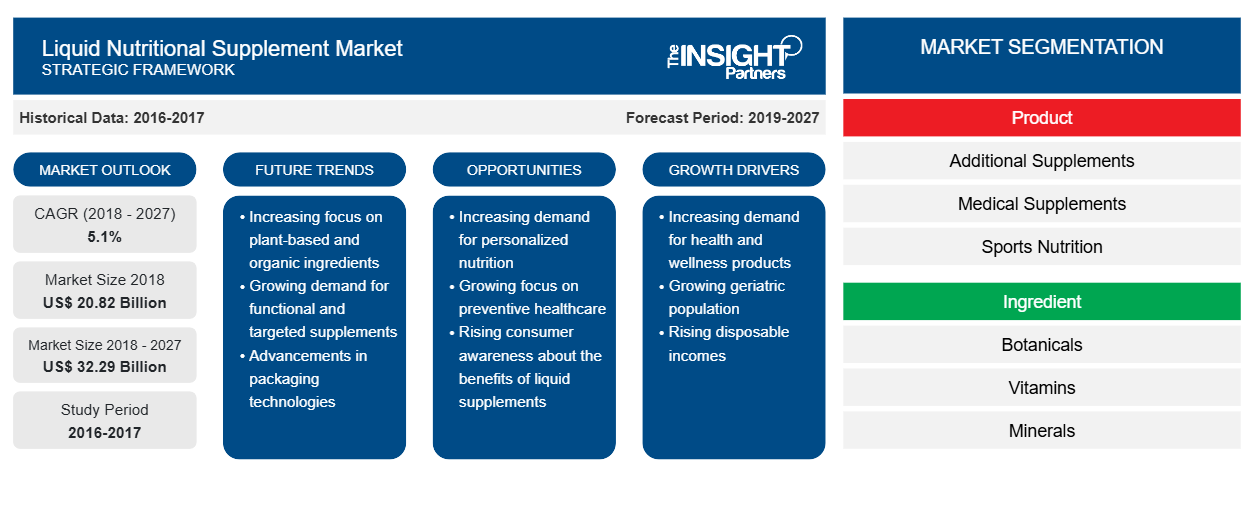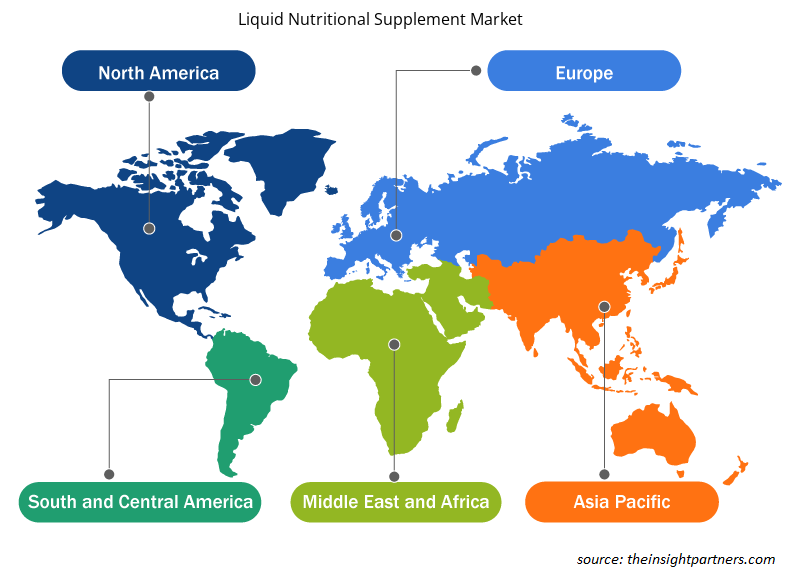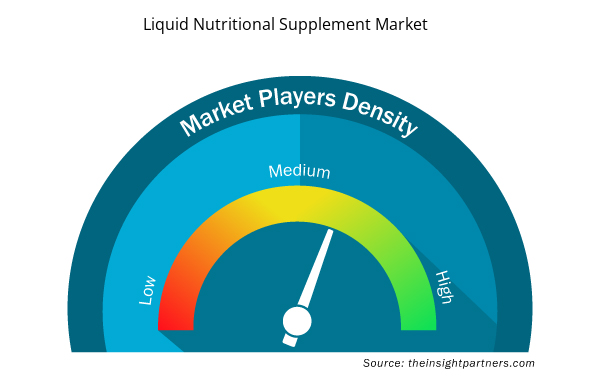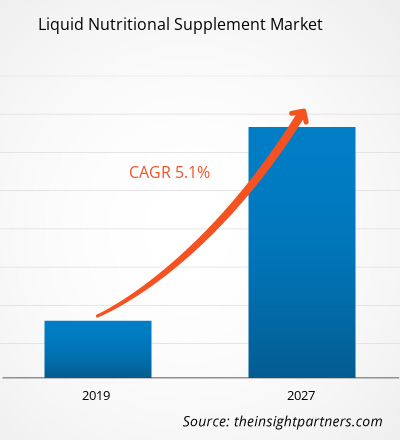The liquid nutritional supplement market was valued at US$ 20,821.15 million in 2018 and it is projected to reach US$ 32,286.12 million in 2027; it is expected to grow at a CAGR of 5.1% from 2019 to 2027.
Liquid nutritional supplements are dietary supplements that are available in liquefied form. They are generally used to improve body metabolism to decrease incidents of lifestyle disorders. They are principally used by consumers that are incapable of consuming dietary supplements in capsule, thick gel, and solid tablet forms. The growth of the global liquid nutritional supplement market is attributed to the growing consumption of liquid nutritional supplements and rising incidence of chronic diseases. However, unpredictable side effects of liquid nutritional supplements is the major factor hindering the market growth.
The global liquid nutritional supplement market is expected to witness substantial growth post-pandemic. The COVID-19 has affected economies and industries in various countries due to lockdowns, travel bans, and business shutdowns. The COVID-19 crisis has overburdened public health systems in many countries and highlighted the strong need for sustainable investment in health systems. As the COVID-19 pandemic progresses, the healthcare industry is expected to see a drop in growth. The life sciences segment thrives due to increased demand for invitro diagnostic products and rising research and development activities worldwide. However, the medical technologies and imaging segment is witnessing drop in sales due to a smaller number of surgeries being carried out and delayed or prolonged equipment procurement. Additionally, virtual consultations by healthcare professionals are expected to become the mainstream care delivery model post-pandemic. With telehealth transforming care delivery, digital health will continue to thrive in coming years. In addition, disrupted clinical trials and the subsequent delay in drug launches is also expected to pave the way for entirely virtual trials in the future. New technologies such as mRNA is expected to emerge and shift the pharmaceutical industry and market is also expected to witness more vertical integration and joint ventures in coming years.
Customize This Report To Suit Your Requirement
You will get customization on any report - free of charge - including parts of this report, or country-level analysis, Excel Data pack, as well as avail great offers and discounts for start-ups & universities
Liquid Nutritional Supplement Market: Strategic Insights

- Get Top Key Market Trends of this report.This FREE sample will include data analysis, ranging from market trends to estimates and forecasts.
You will get customization on any report - free of charge - including parts of this report, or country-level analysis, Excel Data pack, as well as avail great offers and discounts for start-ups & universities
Liquid Nutritional Supplement Market: Strategic Insights

- Get Top Key Market Trends of this report.This FREE sample will include data analysis, ranging from market trends to estimates and forecasts.
Market Insights
Growing Consumption of Liquid Nutritional Supplements to Drive Global Liquid Nutritional Supplement Market Growth
Developments in the life sciences and food industries have resulted in a vital transformation that has allowed introduction of liquid nutrition supplements. Incorporation of various essential nutrients, such as vitamins, minerals, and proteins, in a single nutritional supplement drink leads to high preference for these drinks among people. Technological developments have also enabled manufacturers to introduce ready-to-drink nutritional liquids that rule out the efforts required in preparing the drink.
The popularity of liquid nutritional supplements is increasing among all the age groups, such as adults, children, and elderlies. While the consumption of these drinks is more common among the adults as they require more nutrition to balance their stressful lifestyles, easy consumption, handling, and storage are further boosting their popularity among the population of other age groups. The adult group of people includes working population, athletes, sports players, lactating mothers, pregnant women, fitness enthusiasts, and others. The ready-to-drink liquids can be stored for a longer period of time and consumed whenever required, thereby saving time of consumers. The demand for medical supplements in the liquid forms, such as of juices and milkshakes, are growing among the all age groups of people.
Increasing efforts in research and development have led to the introduction of variants suitable for people suffering from diseases that lead to diet-related restrictions on the consumers. For instance, Nestlé offers BOOST Glucose Control, which is a balanced nutritional drink, which is specially formulated for diabetic people. Thus, the availability of various such products in the market is likely to drive the growth of the market during the forecast period.
Product -Based Insights
In terms of product, the global liquid nutritional supplement market is segmented into additional supplement, medical supplement and sport nutrition. In 2018, the additional supplement segment held largest share of the market. However, the sports nutrition segment is estimated to register the highest CAGR during the forecast period.
Ingredient -Based Insights
Based on ingredient, the global liquid nutritional supplement market is segmented into botanical, vitamins, minerals, proteins & amino acids and others. The vitamins segment held the largest market share in 2018. However, botanicals segment is estimated to grow at the fastest rate during the forecast period.
Age Group -Based Insights
Based on age group, the global liquid nutritional supplement market is segmented into infant, children, adults, and old age. The adults segment held the largest market share in 2018. However, old age segment is estimated to register the highest CAGR during the forecast period.
Route of Administration -Based Insights
Based on route of administration, the global liquid nutritional supplement market is segmented into oral, enteral, and parenteral. The oral segment held the largest market share in 2018. Also, the same segment is estimated to register the highest CAGR during the forecast period.
Distribution Channel -Based Insights
In terms of distribution channel, the global liquid nutritional supplement market is segmented into online channels and offline channels. The offline channels segment held the largest share of the market in 2018. However, online channels segment is estimated to register the highest CAGR during the forecast period.
The global liquid nutritional supplement market players are adopting the product launch and expansion strategies to cater to changing customer demands worldwide, which also allows them to maintain their brand name globally.
Liquid Nutritional Supplement Market Regional Insights
The regional trends and factors influencing the Liquid Nutritional Supplement Market throughout the forecast period have been thoroughly explained by the analysts at Insight Partners. This section also discusses Liquid Nutritional Supplement Market segments and geography across North America, Europe, Asia Pacific, Middle East and Africa, and South and Central America.

- Get the Regional Specific Data for Liquid Nutritional Supplement Market
Liquid Nutritional Supplement Market Report Scope
| Report Attribute | Details |
|---|---|
| Market size in 2018 | US$ 20.82 Billion |
| Market Size by 2027 | US$ 32.29 Billion |
| Global CAGR (2018 - 2027) | 5.1% |
| Historical Data | 2016-2017 |
| Forecast period | 2019-2027 |
| Segments Covered |
By Product
|
| Regions and Countries Covered | North America
|
| Market leaders and key company profiles |
Liquid Nutritional Supplement Market Players Density: Understanding Its Impact on Business Dynamics
The Liquid Nutritional Supplement Market is growing rapidly, driven by increasing end-user demand due to factors such as evolving consumer preferences, technological advancements, and greater awareness of the product's benefits. As demand rises, businesses are expanding their offerings, innovating to meet consumer needs, and capitalizing on emerging trends, which further fuels market growth.
Market players density refers to the distribution of firms or companies operating within a particular market or industry. It indicates how many competitors (market players) are present in a given market space relative to its size or total market value.
Major Companies operating in the Liquid Nutritional Supplement Market are:
- Abbott
- Amway
- Herbalife International of America, Inc.
- ADM
- Arkopharma
Disclaimer: The companies listed above are not ranked in any particular order.

- Get the Liquid Nutritional Supplement Market top key players overview
Global Liquid Nutritional Supplement Market – by Product
- Additional Supplements
- Medical Supplements
- Sports Nutrition
Global Liquid Nutritional Supplement Market – by Ingredient
- Botanicals
- Vitamins
- Minerals
- Proteins and Amino Acids
- Casein
- Whey Protein
- Soy Protein
- Pea Protein
- Others
Global Liquid Nutritional Supplement Market – by Age Group
- Infants
- Children
- Adults
- Old Age
Global Liquid Nutritional Supplement Market – by Route of Administration
- Oral
- Enteral
- Parenteral
Global Liquid Nutritional Supplement Market – by Distribution Channel
- Online Channels
- Offline Channels
- Pharmacy Chains
- Supermarkets
- Drug Stores
Global Liquid Nutritional Supplement Market – by Geography
- North America
- US
- Canada
- Mexico
- Europe
- France
- Germany
- Italy
- UK
- Spain
- Rest of Europe
- Asia Pacific (APAC)
- China
- India
- South Korea
- Japan
- Australia
- Rest of APAC
- Middle East & Africa (MEA)
- South Africa
- Saudi Arabia
- UAE
- Rest of MEA
- South America and Central America (SCAM)
- Brazil
- Argentina
- Rest of SCAM
Company Profiles
- Abbott
- Amway
- Herbalife International of America, Inc.
- ADM
- Arkopharma
- Glanbia Nutritionals
- Liquid Health, Inc.
- Bayer AG
- The Nature's Bounty Co
- GlaxoSmithKline.
- Historical Analysis (2 Years), Base Year, Forecast (7 Years) with CAGR
- PEST and SWOT Analysis
- Market Size Value / Volume - Global, Regional, Country
- Industry and Competitive Landscape
- Excel Dataset



Report Coverage
Revenue forecast, Company Analysis, Industry landscape, Growth factors, and Trends

Segment Covered
Product ; Ingredient ; Age Group ; Route of Administration ; Distribution Channel , and Geography

Regional Scope
North America, Europe, Asia Pacific, Middle East & Africa, South & Central America

Country Scope
Argentina, Australia, Brazil, Canada, China, France, Germany, India, Italy, Japan, Mexico, Saudi Arabia, South Africa, South Korea, Spain, United Arab Emirates, United Kingdom, United States
Frequently Asked Questions
What is the average selling price of a liquid nutritional supplement?
Liquid nutritional supplement's price may vary as per the components, ingredients, and volume of the drink. The average selling price of a liquid nutritional supplement drink is nearly US$ 50 – US$500. The prices are also based on the manufacturing companies and their distribution in different companies.
What are the market driving factors for liquid nutritional supplement market?
Factors such as growing consumption of liquid nutritional supplements, and rising incidence of chronic diseases drive the market. Additionally, personalized liquid nutritional supplement is expected to be future trend for the growth of market.
What is a liquid nutritional supplement?
Liquid nutritional supplement is dietary supplement available in liquid form. It is generally used to improve body metabolism to decrease incidents of lifestyle disorders. It is principally used by consumers that are incapable of consuming dietary supplements in capsule, thick gel, and solid tablet forms.
Trends and growth analysis reports related to Consumer Goods : READ MORE..
The List of Companies in Liquid Nutritional Supplement Market
- Abbott
- Amway
- Herbalife International of America, Inc.
- ADM
- Arkopharma
- Glanbia Nutritionals
- Liquid Health, Inc
- Bayer AG
- The Nature's Bounty Co
- GlaxoSmithKline plc.

 Get Free Sample For
Get Free Sample For